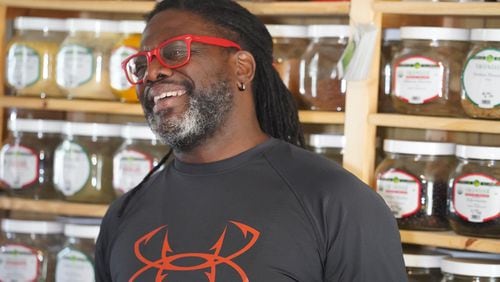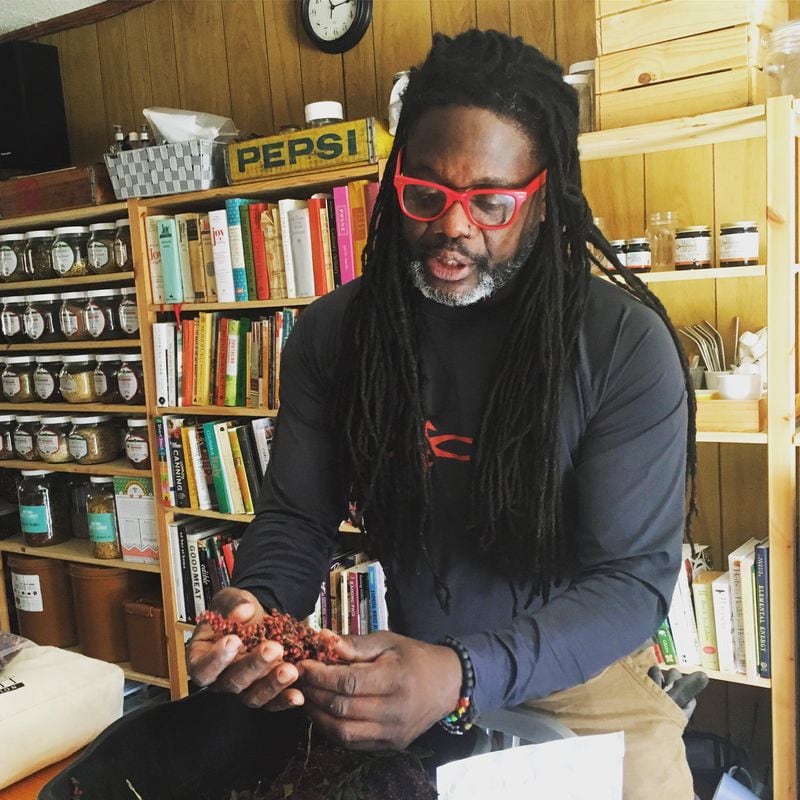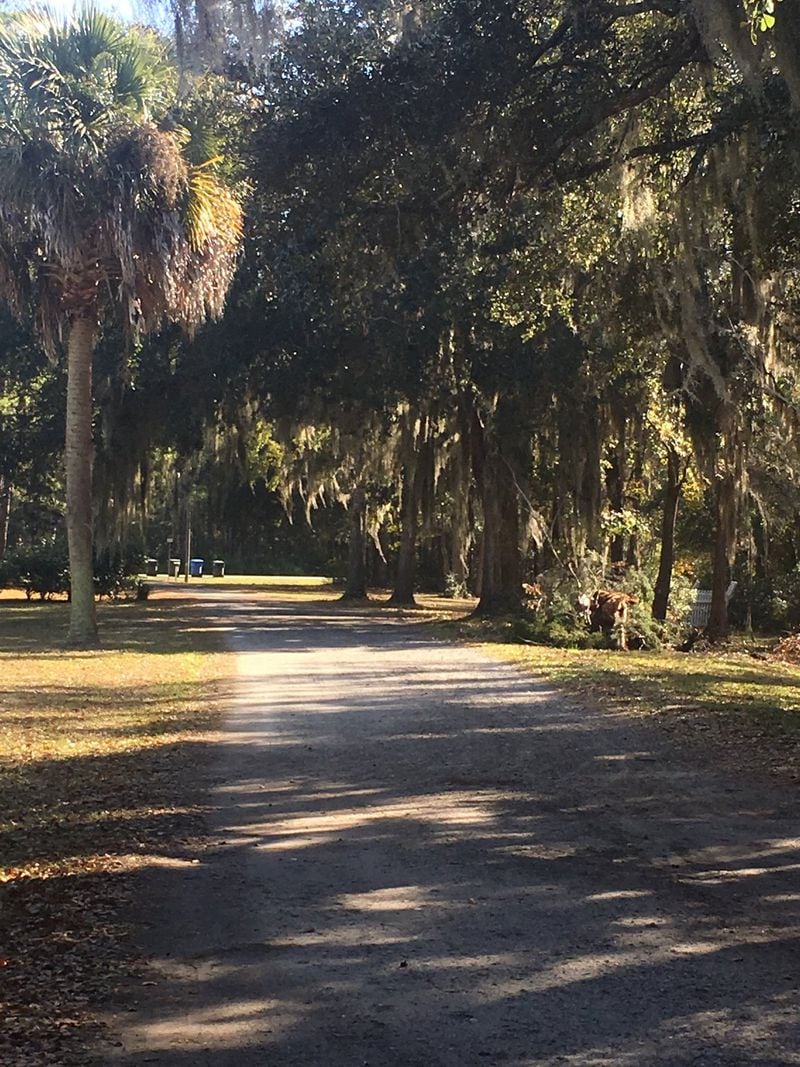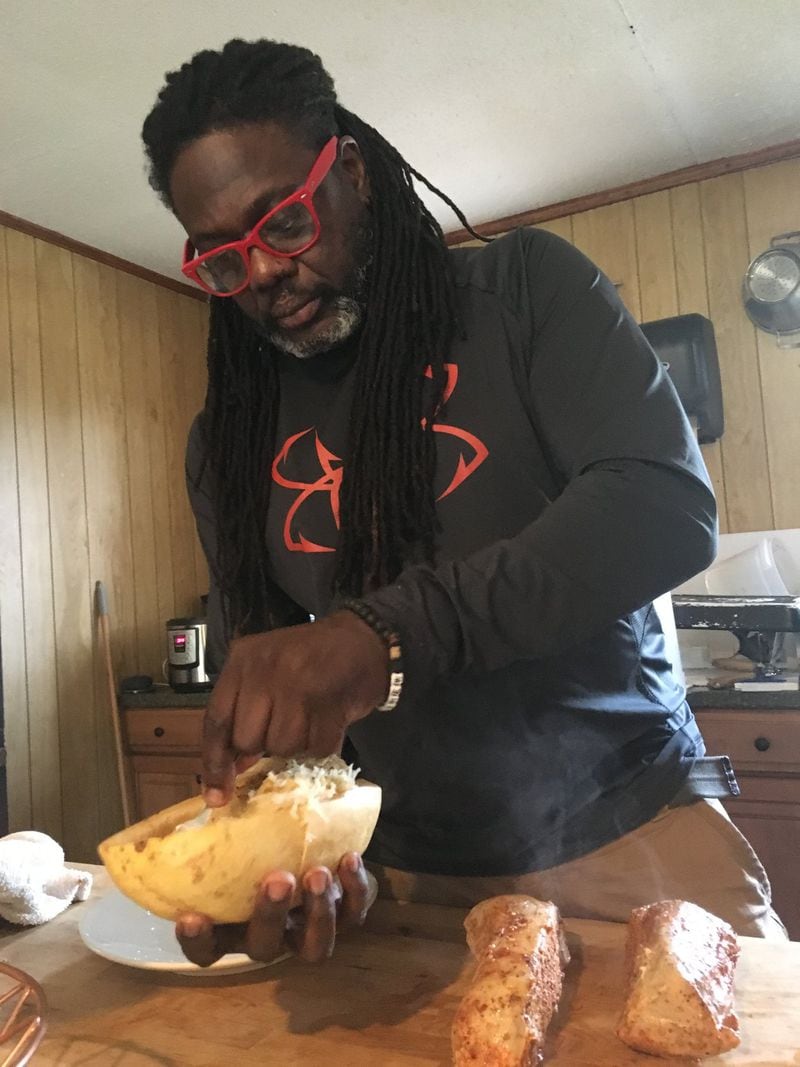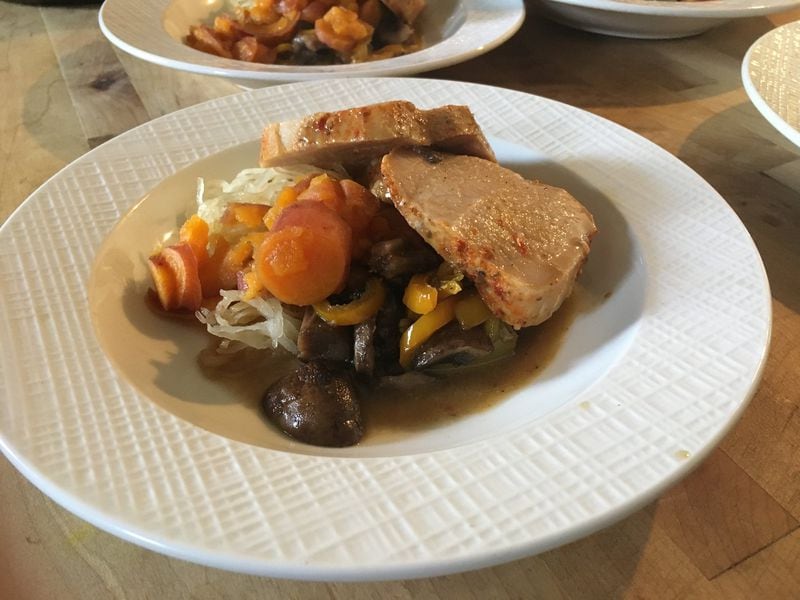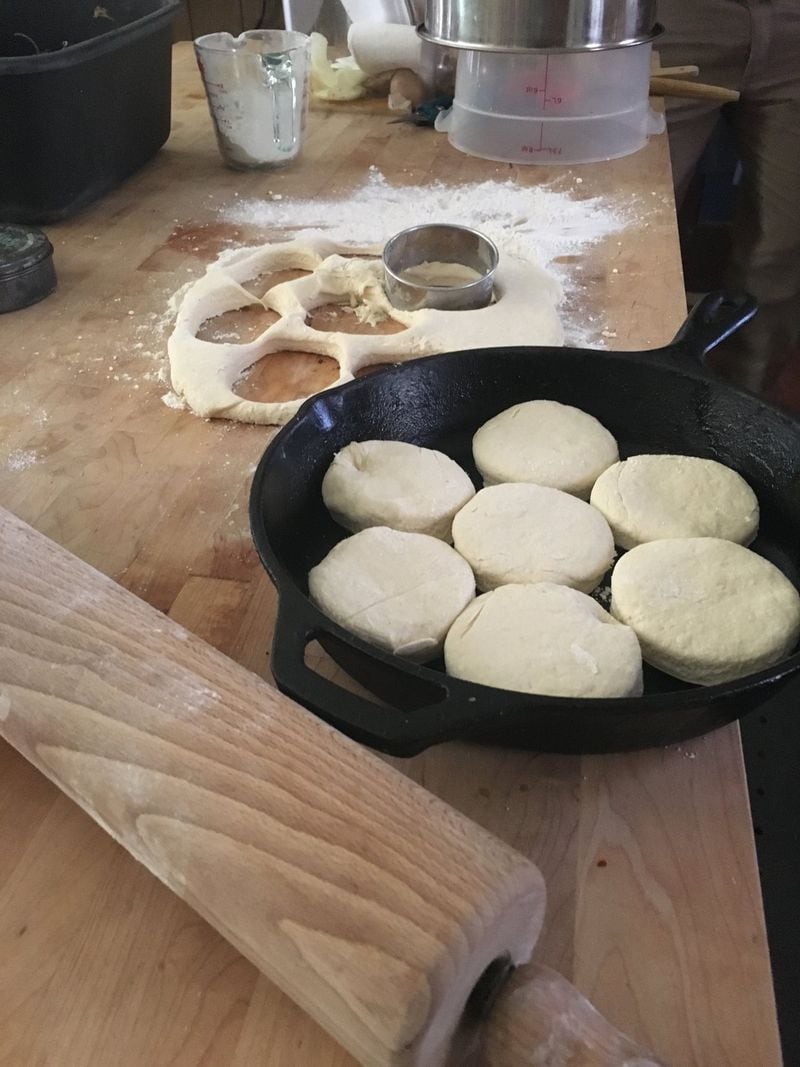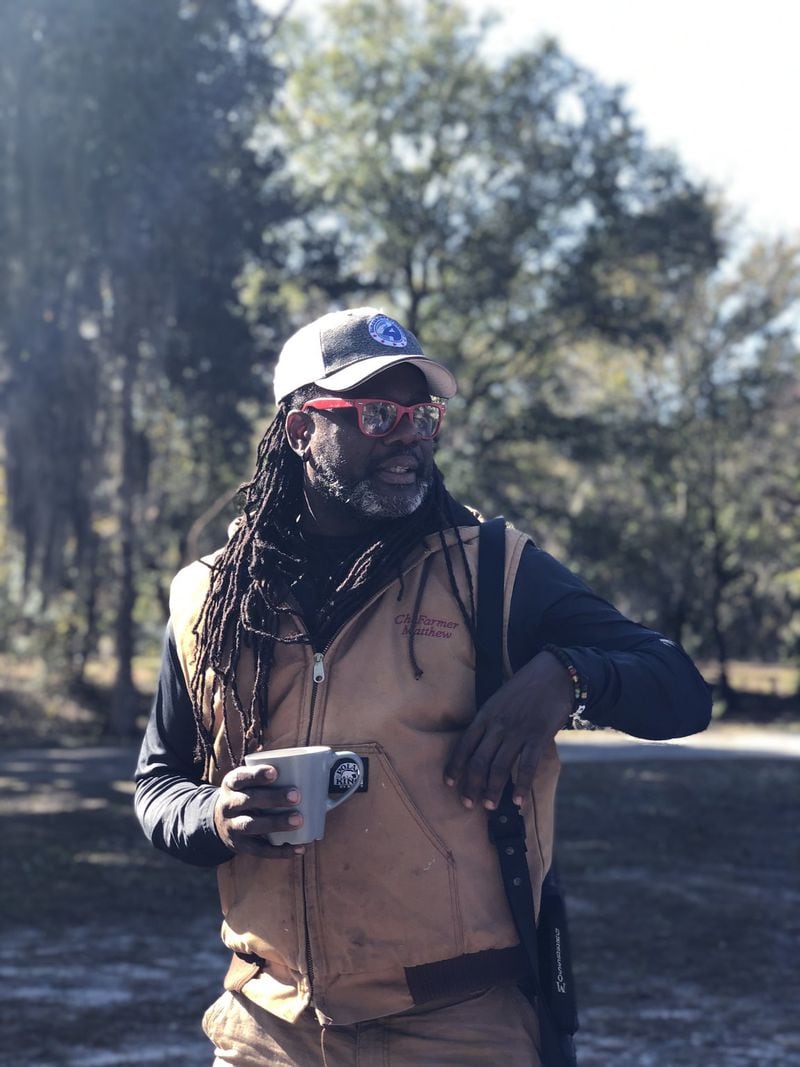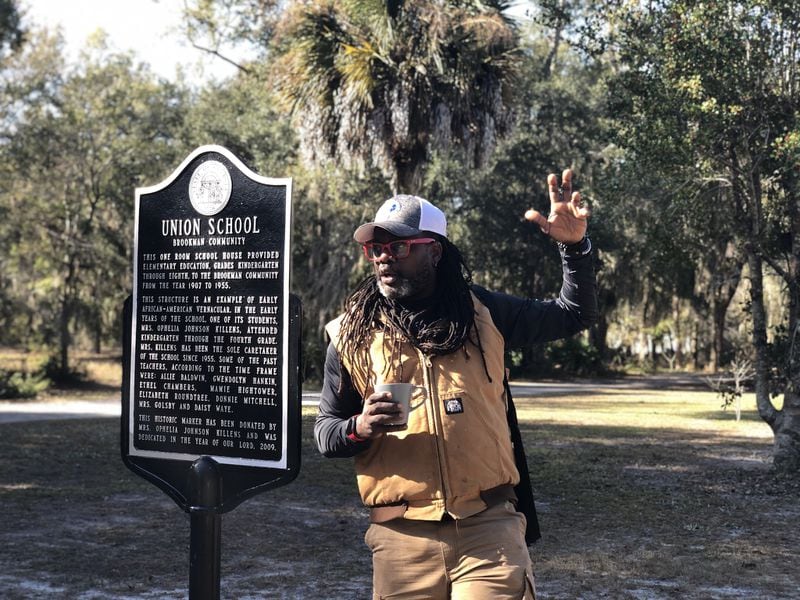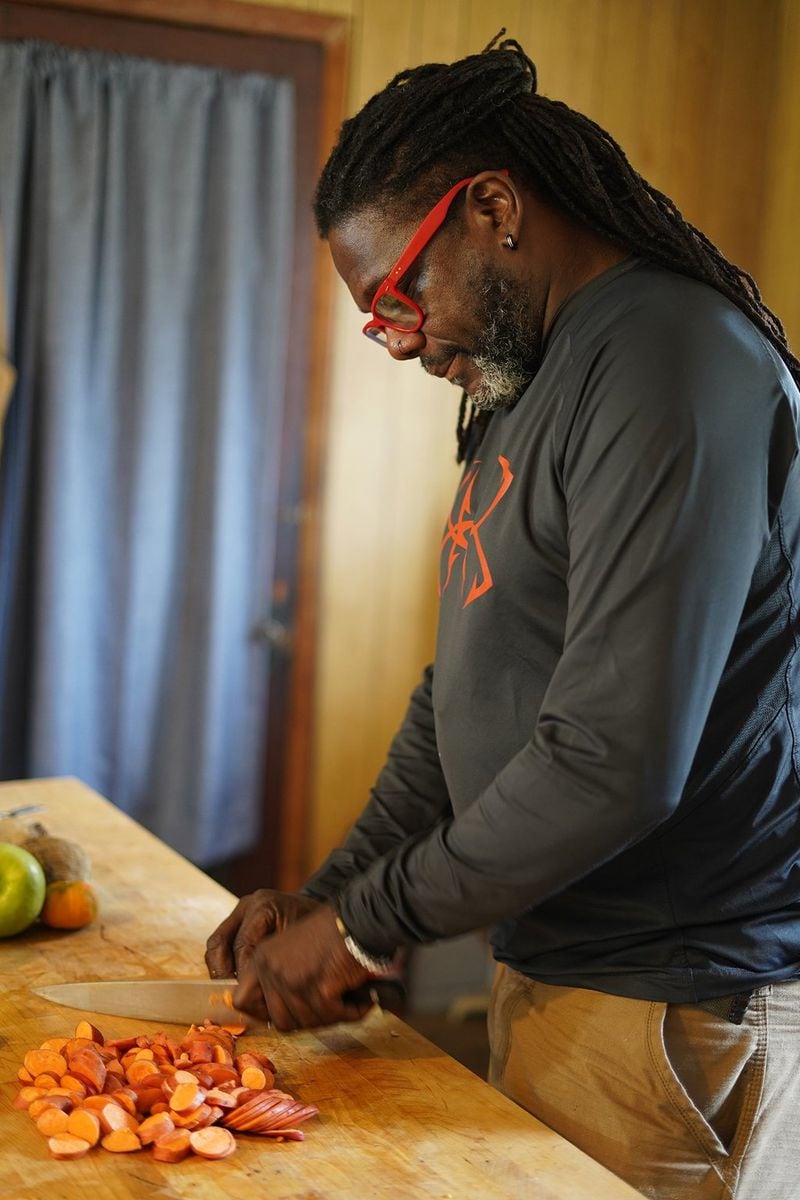BRUNSWICK — At Gilliard Farms, chef Matthew Raiford gets his hands in the soil to dig, and the grit on his boots proves it.
It’s the surprise of hearing the words chef and farmer together that first gets interest, but Raiford offers more: food as part of natural patterns, soil knowledge, and flavors that mix both land and sea. His Gullah Geechee farming methods and chef’s sensibility ensure that Raiford takes the long view when it comes to food.
But make no mistake, Raiford is not advocating old ways of farming or cooking exclusive of new technology. While his cooking space includes an old wooden Pepsi crate, a red ice box reminiscent of earlier days outside the door, and ingredients from wild-grown plants flavoring foods from ancient times, he cooked lunch sous vide, and called over his shoulder, “Hey, Google. Timer: 10 minutes,” to make sure biscuits baking in a cast-iron skillet were not overdone.
Raiford, 52, a 2018 James Beard semifinalist for Best Chef in the Southeast, is indeed an old-ways culinarian, and the rare chef who actually lives on the farm. His hands-in-the-dirt perspective adds to his place among chefs that are making a statement across the country: black chefs like New York native Mashama Bailey of the Grey in Savannah or Florida chef Edouardo Jordan, who now runs two successful concepts in Seattle.
“I think that we are very similar (in the way) we are trying to show our foodways for what they are,” Raiford says. “They’re part of a national story that has been pushed to the wayside. Now it’s coming forward.”
This national food story links a fraught past to bountiful flavor and has been rising in awareness not just throughout the South but across the country. Eating at Raiford’s table, with wild-grown herbs flavoring sauces, jellies made from last season’s fruit, and squash grown within yards of the house, renews the idea that there’s much to learn from land-based knowledge, and from the human capacity to fashion flavorful food out of scarcity.
“You talking about farming?” Raiford recalls the grandmother he called Nana saying to him when he told her about organic agriculture. “Wait. You went to school to learn what we already know how to do?”
Raiford did indeed go to school to learn about organic agriculture at the University of Santa Cruz Center for Agroecology and Sustainable Foods in California. But first, after nearly 10 years in the U.S. Army and an early interest in pursuing physical therapy at Howard University, he engaged his keen focus on food and went to culinary school, initially at Leesburg, Virginia, then at the Culinary Institute of America in Hyde Park, New York.
It was a good decision: Raiford has gone on to receive national attention not only by the James Beard Foundation but the notice of chefs such as Alice Waters, whose presence at this year’s Georgia Organics conference comes at his behest. (Georgia Organics is an organization that supports best practices for organic farmers, eaters and gardeners in Georgia.) Mentors close to home helped shape his journey.
“I think I would have followed my culinary career down a different path if I had never met chef Joe Randall in Savannah.” Randall, noted for mentoring culinary professionals, is a member of the African American Chefs Hall of Fame with a 53-plus-year history of making magic with Southern cuisine.
“Uncle Joe” Randall, as he is called, encouraged Raiford to build from what he knew. “He showed me that I could embrace my culinary roots.”
To Raiford, that meant the flavors of the Gullah Geechee, a culture descending from enslaved Africans originally from the rice-growing region of West Africa.
“I always loved the food that I came from. I just loved it. Growing up, I had my Nana, my great-grandmother, my dad — all these people cooking around me.”
Raiford, whose father was a professional baker, was inspired by waking to a house scented by fresh apple and cinnamon. “My dad made these really light apple turnover pastries. You can’t beat that.”
Tactile memory of baking aromas, of making syrup from sugar cane raised on the farm, of running through Georgia woodlands, creates the flavor profile for Raiford the chef. More, his past makes him at ease on the land.
“I just planted these,” he says, raking his hands through soil to replant garlic bulbs recently pecked free. “This is what a chicken does.”
Where the Wild Things Are
In addition to the uprooted garlic, a variety of vegetables, and fruit trees, magic happens each season on a section of Gilliard Farms that the family calls Where the Wild Things Are. Walking through with roosters crowing, Raiford pulls back a young milk thistle that will be harvested this spring for tincture.
“This one will be one of the strong ones,” he says with satisfaction. “It’ll probably grow to have a head like this,” and his hands spread about 12 inches.
So many edibles are unknown, he says. But growing up outside, running the farm, made him more aware than most of abundance.
“I was like a bull in the woods,” Raiford says, “running through grabbing things to eat: sour grass to quench my thirst, pawpaw, Southern huckleberries, blackberries, everything.”
A new venture adds the skills of his partner, Jovan Sage, herbalist, doula, and proprietor of Sage's Larder, to the creation of a smooth gin with farm-grown hibiscus, an age-old Gullah Geechee ingredient. The two launched Gullah Geechee Gin in partnership with Justin Douglas of Simple Man Distillery in Atlanta in January (available in Atlanta at Total Wine, Tower Beer Wine & Spirits, Green's and other locations updated at smdistillery.com). They aim for 3,000 bottles by June and are completing the organic certification process.
Raiford shakes out scratchy hibiscus buds from a paper envelope to show the latest harvest. A flush of purple on the straw-colored husks is still evident as small bumpy black seeds spill out.
“Jovan harvests all the botanicals for the gin from the farm, except for the juniper, which she sources organically.”
The harvest of wild-grown plants and saving seeds are not new to Gilliard Farms.
“In U.S. history, black farmers didn’t have access to the pre-coated ‘better’ seed. My grandfathers always saved seed.”
Restrictions for black farmers led to an appreciation for what the land provided. As the sixth generation on the farm, with his children as its seventh, Raiford and his sister Althea, also a U.S. military veteran, an amazing cook, and deft work partner at planting and harvesting time, own 30 acres of the original 474-acre farm established by their great-great-great-grandfather Jupiter Gilliard in 1874. Today, it is one of just over 35,000 farms owned by black Americans, out of a total of over 2 million farms in the U.S., according to the USDA 2017 Census of Agriculture released in October.
This number, less than 2% of all farms, has fallen from a peak in 1920 of 14%, and is increasingly attributed to legal mechanisms and racist policies, according to sources such as Summer Sewell in the Guardian, and Leah Penniman in her book "Farming While Black," among others.
Cooking lab
Interest in the legacy of the land is evident in what Raiford calls his cooking lab, a room lined with cookbooks and jars filled with dried botanicals. Bottle labels read Comfrey Leaf, Yerba Mate, Thyme, Brown Mustard, Echinacea Purpurea, and many more. A jar labeled Hoodoo sits next to a stainless-steel canister marked “clean spoons.” There’s a large plastic bag containing nettle leaf, and a cookbook open to pages that outline “scheduling sourdough in the kitchen.”
Raiford casually produces an exquisite meal of hibiscus gin-glazed pork loin, cinnamon-roasted spaghetti squash, orange- and ghee-glazed sweet potatoes, and a mushroom and pepper saute, using sous vide equipment. He dishes out warm biscuits from a cast-iron pan, and serves them with farm-made blueberry, lemon and thyme jelly. This after uprooting the sweet potatoes by hand in the field and replanting the garlic.
The man can multitask.
After being the executive chef of Haute Catering in Washington, D.C., at the U.S. House of Representatives and trying his hand at operating, and subsequently closing, the Farmer's Larder and Strong Roots Provisions restaurants in Brunswick, among other work experiences, Raiford now plans to focus on where he started: events on the farm, pop-ups across the country, and the new gin venture. (Announcements for farm events and pop-ups will be posted on his Facebook and Instagram pages.)
“In the beginning, my grandmother was part of all the farm event preparations,” he says. “Doing this work again feels right.”
As a member of the board of directors of Georgia Organics, Raiford has planned a new Black Farmer Prosperity track for its annual conference Feb. 7-8 in Athens. His session with Sage, “Collards Aren’t the New Kale,” is, in a sense, about authenticity.
“Oftentimes, we try to jump on a bandwagon of whatever is hot. What I am consistently looking at is what grows well in our soil and what do people want to eat.”
Sage adds, “And, how do you stay culturally relevant and not colonize people’s diets?”
This is sustainability for Raiford, plus one other critical issue.
“We’ve fought nature so much that we’ve killed the soil. We’ve killed all the micro-organisms that are in the soil that were regenerating it,” he says. Raiford works mightily to address this issue with foods in sync with the region.
This means it isn’t all soil and toil. For Raiford, Gullah Geechee means seafood.
“I grew up eating a mess of fish or shrimp and greens,” he says. Fresh, tasty, with no cloudy eyes and wan-colored skin in sight — these were not your grocery store fish. What showed up off the coastal Georgia waters were the highlight of the family table.
“Being on the coast, it wasn’t about raising cattle.”
What it was about was tributaries, streams, creeks and “lots of ocean.” Raiford, who knows how to cast a net into the ocean and pull back bounty, grew up seining and making crab baskets off the St. Simons Island Pier.
“I know how to fish with a cane pole. I know how to fish with a rod and reel. I know how to fish with nets. Now, I’m getting ready to add fly-fishing to my repertoire.”
Antiquity now
The farm’s nearly 150 years of organic non-GMO practices, due in part to a history of barred access and the expense of chemicals, is now reaping rewards. Even with a generation gap between his grandfather’s time and his, Raiford sees the way forward is steeped in the past.
“When I first heard of dry farming, I was like, ‘Oh, you mean like the original way people farmed?’ I grew up with that. I thought that everybody had to farm that way unless you had a lot of money for irrigation.”
With words like regenerative agriculture and dry farming rising in use, Raiford wants to close the knowledge gap from previous generations.
“We aren’t that far removed from that land-based knowledge. I see my role in that gap. There are some amazing chefs out there starting to talk about everything from eating your weeds to using tillage radishes as part of the meal.”
Developments touted as new, such as adding fish bones to compost to increase the calcium content and reduce risk of nematodes that kill roots, was something he watched his grandfather do, though without the same vocabulary.
“These techniques have been here all along. As the saying goes, nothing gets old but clothes and those come back.”
Raiford, who often wears red-framed glasses, heavy work pants that can withstand snagging on plants or equipment, and T-shirts to fit the Georgia weather, pauses to pick up what he calls his snake stick to walk the farm.
“It’s a Mossberg.”
Despite the precaution of carrying his firearm made by the Mossberg company, no snakes appear even though the open land in Where the Wild Things Are and a magnificent Spanish oak dripping moss suggest that they could. Oyster shells dot the garden from a recent oyster roast held on tin sheets of roofing. A few unmoored garlic bulbs remain scattered about, forgotten by the crowing roosters. Several homes dot the edges of the acreage and a dip permanently falls away from what used to be the Southern Railways track running near the Spanish oak.
In addition to the wild things on the property, behind Matthew Raiford’s house there are chicken houses, and beyond that, tilled space that supports an orchard, greens, sugar cane, sumac. He has plans for more. This year: shallots, garlic, peas, sweet potatoes. The old sugarcane press is set up near the house, and though the wood-beamed turnstile is no longer rotated by a mule but by a riding lawnmower, the resulting molasses will be thick and dark and bottled once again for family use.
There’s an old schoolhouse on the property that was the only school for black children for a 25-mile radius from 1907-1955. Raiford’s uncles, aunts and grandmother all studied there; his mother was of the first generation that did not. The family gave up an acre of land for the school and were at the ready with food from the farm for the children who attended from such great distances.
“We wanted to make sure that everyone got to eat.”
Feeding people was ingrained. The silty-sandy loam at Gilliard Farms holds multiple histories, and Raiford lives out one of them in sync with the land and the food it provides.
RECIPES
Effie’s Shrimp Perloo
Perloo is a Lowcountry shellfish and rice dish. Similar to jambalaya and paella, it starts with a flavorful base of rice simmered with garlic, onion and bell peppers.
“When I was a kid, my mom used to make this dish often for family gatherings and potluck events,” said chef-farmer Matthew Raiford. “It was her way of stretching food for us at home, and also saying thank you to whoever was hosting the family gathering or potluck because it was obviously homemade. Who goes out and buys seafood for a potluck?”
Satsuma Orange Glazed Sweet Potatoes
“I am always trying something new with the Instapot because it makes meals so quick and delicious with just a few ingredients. I also don’t have to stand over the stove, especially when I need to get crops in the ground or it’s harvest time,” said chef-farmer Matthew Raiford.
If you don’t have an Instapot or other pressure cooker, Raiford offers stovetop instructions.
Nina Mukerjee Furstenau is a journalist and author of the award-winning book “Biting Through the Skin: An Indian Kitchen in America’s Heartland.” She is editor of the FoodStory book series at the University of Iowa Press and her essays can be found at ninafurstenau.com.
Read more stories like this by liking Atlanta Restaurant Scene on Facebook, following @ATLDiningNews on Twitter and @ajcdining on Instagram.
About the Author
